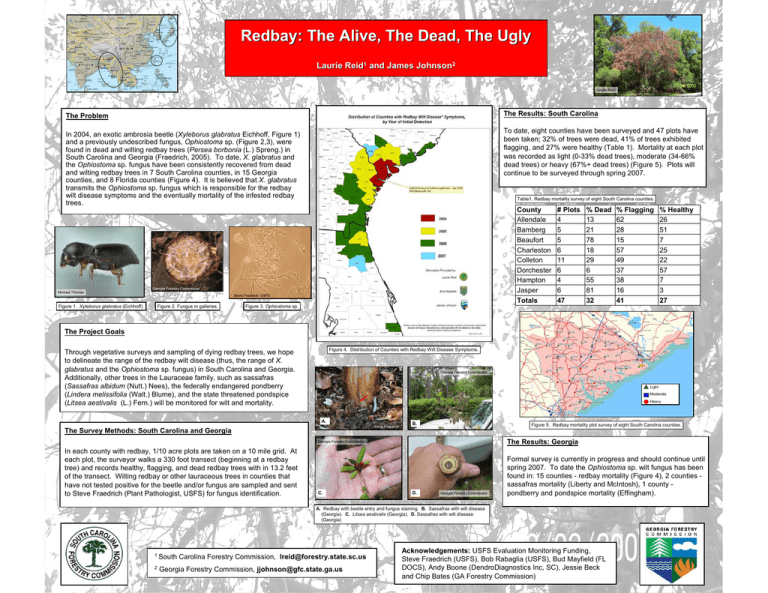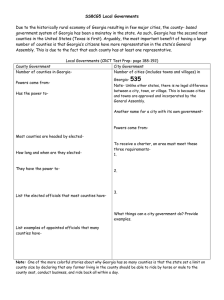Redbay: The Alive, The Dead, The Ugly Laurie Reid and James Johnson
advertisement

Redbay: The Alive, The Dead, The Ugly Laurie Reid1 and James Johnson2 Laurie Reid The Results: South Carolina The Problem To date, eight counties have been surveyed and 47 plots have been taken; 32% of trees were dead, 41% of trees exhibited flagging, and 27% were healthy (Table 1). Mortality at each plot was recorded as light (0-33% dead trees), moderate (34-66% dead trees) or heavy (67%+ dead trees) (Figure 5). Plots will continue to be surveyed through spring 2007. In 2004, an exotic ambrosia beetle (Xyleborus glabratus Eichhoff, Figure 1) and a previously undescribed fungus, Ophiostoma sp. (Figure 2,3), were found in dead and wilting redbay trees (Persea borbonia (L.) Spreng.) in South Carolina and Georgia (Fraedrich, 2005). To date, X. glabratus and the Ophiostoma sp. fungus have been consistently recovered from dead and wilting redbay trees in 7 South Carolina counties, in 15 Georgia counties, and 8 Florida counties (Figure 4). It is believed that X. glabratus transmits the Ophiostoma sp. fungus which is responsible for the redbay wilt disease symptoms and the eventually mortality of the infested redbay trees. Michael Thomas, FLDOCS Table1. Redbay mortality survey of eight South Carolina counties. County Allendale Bamberg Beaufort Charleston Colleton Dorchester Hampton Jasper Totals Georgia Forestry Commission Michael Thomas Steve Fraedrich, USFS Figure 1. Xyleborus glabratus (Eichhoff) Figure 2. Fungus in galleries. # Plots 4 5 5 6 11 6 4 6 47 % Dead 13 21 78 18 29 6 55 81 32 % Flagging 62 28 15 57 49 37 38 16 41 % Healthy 26 51 7 25 22 57 7 3 27 Figure 3. Ophiostoma sp. The Project Goals Figure 4. Distribution of Counties with Redbay Wilt Disease Symptoms. Through vegetative surveys and sampling of dying redbay trees, we hope to delineate the range of the redbay wilt disease (thus, the range of X. glabratus and the Ophiostoma sp. fungus) in South Carolina and Georgia. Additionally, other trees in the Lauraceae family, such as sassafras (Sassafras albidum (Nutt.) Nees), the federally endangered pondberry (Lindera melissifolia (Walt.) Blume), and the state threatened pondspice (Litsea aestivalis (L.) Fern.) will be monitored for wilt and mortality. Georgia Forestry Commission Light Moderate Heavy A. Steve Fraedrich The Survey Methods: South Carolina and Georgia B. Figure 5. Redbay mortality plot survey of eight South Carolina counties. The Results: Georgia Georgia Forestry Commission In each county with redbay, 1/10 acre plots are taken on a 10 mile grid. At each plot, the surveyor walks a 330 foot transect (beginning at a redbay tree) and records healthy, flagging, and dead redbay trees with in 13.2 feet of the transect. Wilting redbay or other lauraceous trees in counties that have not tested positive for the beetle and/or fungus are sampled and sent to Steve Fraedrich (Plant Pathologist, USFS) for fungus identification. C. D. Georgia Forestry Commission Formal survey is currently in progress and should continue until spring 2007. To date the Ophiostoma sp. wilt fungus has been found in: 15 counties - redbay mortality (Figure 4), 2 counties sassafras mortality (Liberty and McIntosh), 1 county pondberry and pondspice mortality (Effingham). A. Redbay with beetle entry and fungus staining. B. Sassafras with wilt disease (Georgia). C. Litsea aestivalis (Georgia). D. Sassafras with wilt disease (Georgia) 1 South 2 Carolina Forestry Commission, lreid@forestry.state.sc.us Georgia Forestry Commission, jjohnson@gfc.state.ga.us Acknowledgements: USFS Evaluation Monitoring Funding, Steve Fraedrich (USFS), Bob Rabaglia (USFS), Bud Mayfield (FL DOCS), Andy Boone (DendroDiagnostics Inc, SC), Jessie Beck and Chip Bates (GA Forestry Commission)



